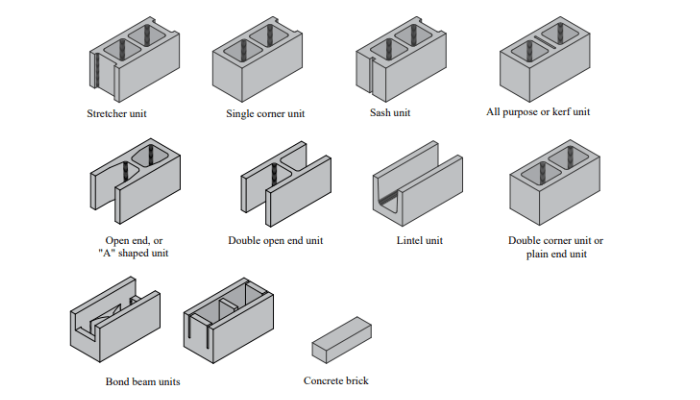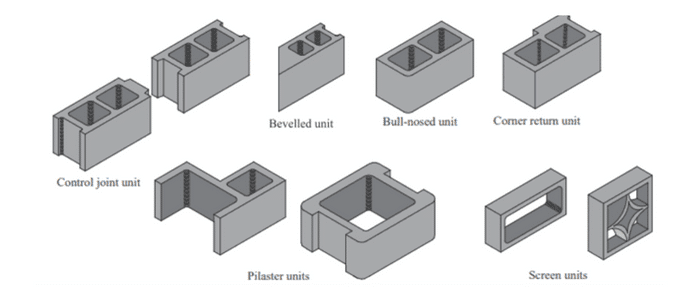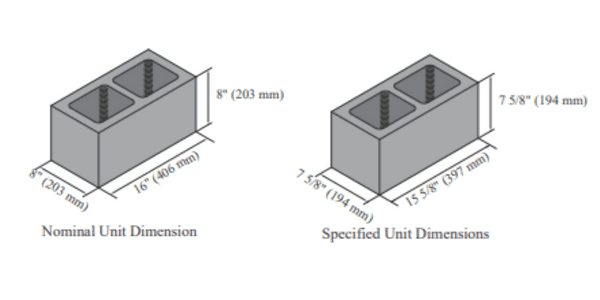Table of Contents
What is CMU Wall?
The concrete masonry unit wall is the full name of the CMU wall. CMU block is a versatile, green building material that may be employed for various objectives.
They may be utilized to add interest to interior walls as well as create an appealing outside design thanks to the diversity of shapes and sizes that are available.
Utilizing concrete blocks in a project may even help it earn the title of “green” building.
A concrete block that is larger than 4″ x 4″ x 12 inches is considered to be a CMU according to the most recent International Building Code.
Bricks made of concrete can be used to describe them if they are smaller. Any size concrete block is made of aggregates and Portland cement.
A cinder block is identical to a concrete block, with the exception that some of the aggregates have been replaced by recycled ash or cinders.
Properties of CMU Wall
The primary ingredients used to create concrete blocks are Portland cement, fillers, and water.
Another name for it is a concrete masonry unit (CMU). Concrete has a number of appealing qualities that make it a desirable building material for architects and contractors, including the following:
- Durable
- Easy to set up
- Fireproof
- simple to maintain
- There are ornamental finishes available, or they can be added after installation.
Functions of CMU Wall
For residential houses or buildings, bearing walls made of concrete masonry units are useful.
It helps with vertical loads such as vaults, arches, flooring joists, and roof rafters as well as horizontal loads like wind and seismic activity.
Most buildings today are built with concrete blocks or bricks, which create the CMU wall.
The CMU system stacks concrete blocks together using mortar joints in a manner akin to stone masonry.
Some CMUs, however, consists of a lot fewer interconnected systems that interlock like a series of tongues and grooves.
CMU Wall Construction
Though the application of these elements might vary greatly depending on the size, shape, and purpose of the wall, they are generally the same for all walls made with CMUs.
Foundation:
Every CMU wall must be supported by a solid foundation made of poured concrete. The dimensions of the concrete block wall and the load it must support are used to establish the foundation’s depth and size.
However, in most cases, the foundation’s width must be at least double that of the wall, which typically rises around one foot below the frost line.
CMU Block:
The function of the wall and its configuration are typically taken into consideration when choosing the block’s shape and size.
The majority of CMU walls will use a variety of blocks, particularly stretchers and corner units.
Masonry joints
One of two types of mortar, type N for the above grade or type S for the below grade is used to link each layer of the joint to the adjacent blocks.
Walls are built with vertical joints offset (staggered) from one course to the next for increased strength.
Reinforcement
In order to prevent joints from cracking and walls from being destroyed, freestanding walls must often have both vertical and horizontal reinforcement.
For vertical reinforcement, straight-length steel bars are inserted into the concrete mix that is poured into holes of blocks at regular gaps.
After every third or fourth course of the block, metal strips are inserted into the wet mortar to give horizontal reinforcement.
The majority of CMU houses are built with single-wythe walls, which are made of single-wide rows of blocks stacked on top of one another.
You can build double-wythe walls, in which two courses of blocks are put together if you need more structural strength.
CMU Block Shapes
Blocks can have two or more cores and can be solid or hollow. The block’s cross-sectional area is decreased by around 25% as a result of this characteristic.
This material’s advantage is that its lighter weight makes it easier to handle. Depending on your plans, it can also be strengthened with rebar, either horizontally or vertically.

Since hollow concrete blocks take less raw materials, labor, and energy to make, they are also a more cost-effective option.
They are significantly simpler to hoist into position once delivered than their solid equivalents are.

The completely solid blocks have a number of uses, including capping off the top of walls and enhancing building security.
They would always need to be weighed against the expense of employing them when determining if they are the ideal choice for each project because they are more expensive than their hollow counterparts.
CMU Block Size
The actual size of a concrete block (stretcher block), which is produced to the nominal size of 8″ x 8″ x 16″, is 7 5/8″ x 7 5/8″ x 15 5/8″.
This nominal size is used to account for mortar joints. The block itself is a little bit shorter to make room for the mortar that holds it in place.
Various sizes of CMU blocks are produced. They can be identified by their depth or the height of the wall they build.
For instance, a 6-inch CMU has a nominal depth of 6 inches, whereas a 10-inch CMU has a nominal depth of 10 inches.

These blocks are also available in half-sizes, which helps eliminate the need to cut blocks on-site at wall or corner intersections.
To save waste and labor associated with cut blocks, architects always strive to design buildings utilizing nominal proportions to the nearest half-block size.
The sizes of CMU blocks are listed in the table below, both nominally and really. CMU blocks are in basic sizes of 4 inches, 6 inches, 8 inches, 10 inches, and 12 inches, although some manufacturers also provide alternative sizes that are not included below.
| CMU Block | Nominal Size |
|---|---|
| 4″ Full Block | 4″ × 8″ × 16″ |
| 4″ Half Block | 4″ × 8″ × 8″ |
| 6″ Full Block | 6″ × 8″ × 16″ |
| 6″ Half Block | 6″ × 8″ × 8″ |
| 8″ Full Block | 8″ × 8″ × 16″ |
| 8″ Half Block | 8″ × 8″ × 8″ |
| 10″Full Block | 10″ × 8″ × 16″ |
| 10″Half Block | 10″ × 8″ × 8″ |
| 12″ Full Block | 12″ × 8″ × 16″ |
| 12″ Half Block | 12″ × 8″ × 8″ |
CMU Block Detail
When creating concrete blocks, CMU producers must adhere to ASTM requirements. According to the specifications, suitable materials, compressive strength, dimensional tolerance, moisture absorption, and other performance parameters are identified.
Concrete brick is constructed from the same material as concrete block, but it is fabricated in sizes that are similar to those of conventional clay bricks (i.e., 2 and a half inches tall).
The ASTM standards that are relevant to concrete masonry units are included in the following table.
The ICC codes use ASTM C90 as the standard, which applies to the majority of typical CMU construction.
| ASTM Designation | CMU Type |
|---|---|
| ASTM C55 | Concrete Brick |
| ASTM C73 | Calcium Silicate Face Brick |
| ASTM C90 | Load Bearing Concrete Masonry Units |
| ASTM C139 | CMU for construction of Catch Basins and Manholes |
| ASTM C744 | Calcium Silicate Masonry Units and Prefaced Concrete |
| ASTM C936 | Solid Interlocking Concrete Paving Units |
| ASTM C1372 | Segmental Retaining Wall Units |
CMU Block Weight
The weight of CMU blocks is determined by the density of the concrete mix that is utilized.
The three categories of CMU are as follows:
1) Lightweight CMU blocks with a weight of less than 105 lb/ft3
2) Medium-weight CMU blocks are those with weights between 105 and 125 lb/ft3, and
3) CMU Blocks of Normal Weight = 125 lb/ft3 or more in weight
Less expensive, easier to install, and typically with greater fire-resistant characteristics are lighter CMUs.
The transmission of sound is typically reduced, the compressive strength is substantially stronger, and the heat storage capacity is larger with heavier units. They cost more to purchase and install, though.
In cases where a specific weight is necessary, architects must define the CMU weight.
Types of CMU Blocks
Because there are so many different types and designs of CMU blocks, they may be used to build walls in a variety of ways.
Despite the structural similarities among all concrete blocks, a single CMU wall is made up of a variety of different concrete block types.
Each block in the wall has a certain function to perform. The most typical CMU types are the following:
- Stretcher Block: Stretcher blocks, which make up the majority of the wall’s typical CMUs and have a surface for mortar between each one, are used.
- Corner Block: Block ends will be visible at a corner because corner blocks have a flat side.
- Piller Block: Stretcher blocks resemble pillar blocks, however, pillar blocks have flat or smooth ends.
- Jamb And Lintel Block: The shapes of jamb and lintel blocks allow for the construction of windows or doors, and they also feature grooves for providing reinforcement.
- Bull Nose Block: Bull nose blocks have at least one rounded corner for aesthetic purposes.
- Partition Block: For usage in interiors or non-load-bearing walls, a partition block is thinner than a typical CMU.
- Other Block Type: In order to receive reinforcing steel, insulation, or other materials, other block varieties feature a variety of cut-out areas.
- Solid Concrete Block: While hollow concrete blocks can be virtually any shape, solid concrete blocks don’t have a hollow interior.
Compressive Strength of CMU Block
Brick walls and CMU blocks Depending on the type of concrete and mortar used in the construction of the unit, the compressive strength ranges from roughly 1,000 psi (7 MPa) to 5,000 psi (34 MPa).
CMU Block Price
For split-face concrete or cinder blocks, the price of a CMU block is $3 per square foot, with an extra $9 to $12 per square foot for labor, supplies, and equipment used during installation.
Depending on how complex the installation is, a 100-square-foot project will cost between $1,200 and $1,500 to finish. A 100-square-foot wall will cost on average $1,350.
Advantages Of CMU Wall
- CMU systems are less expensive to install since they are larger than regular bricks.
- The CMU walls are strengthened with galvanized steel reinforcing, allowing them to support the additional weight without cracking.
- Because these kinds of walls can withstand extremely strong loads, a stone can pass through other building materials like bricks, plaster, and tiles.
- In areas vulnerable to severe weather events like hurricanes and tornadoes, they are helpful.
- Additionally, the longevity of CMU systems increases the building’s lifespan and reduces the need for ongoing maintenance.
Disadvantages of CMU Wall
- Important amounts of moisture are absorbed by CMU walls.
- To prevent water intrusion, they are frequently weatherproofed or covered with a protective glaze.
- These systems lack flexibility for walls with drastically diverse shapes and sizes and are heavier than wooden or steel ones.
- Concrete blocks take up a lot of room as well since they are difficult to insulate and have a low thermal resistance rating.
- Finally, depending on the region, employing contractors may be expensive.
FAQs
What is a CMU wall?
A concrete masonry unit (CMU) is a rectangular building block with a set size that is used in construction. Because they can be used to create so many different looks, CMUs are among the most adaptable building materials on the market.
What are CMU Blocks?
Concrete masonry unit blocks, also known as CMU blocks, are durable and environmentally friendly building materials that may be utilized to create both appealing external designs and interesting interior wall designs.
Is CMU the same as cinder block?
A cinder block is identical to a concrete block, with the exception that some of the aggregates have been replaced by recycled ash or cinders.
Is CMU load bearing wall?
For residential buildings or structures, the bearing wall is made of concrete masonry units. It helps with vertical loads such as vaults, arches, flooring joists, and roof rafters as well as horizontal loads like wind and seismic activity.
Also, Read
Standard Brick Sizes – Importance, Types & Tolerance
What are AAC Blocks? – Properties, Advantages, And Disadvantages
Standard Room Sizes & Their Location In Residential Building
What is Pointing? Purpose, Method, Types of Pointing